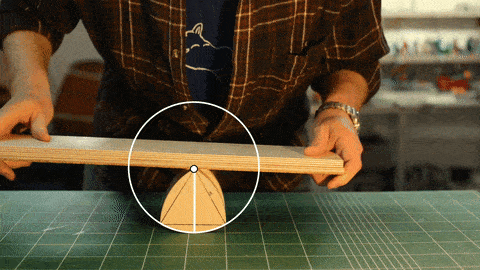Shapes of Constant Width
In the 1960s, the decimal currency act was introduced by the Parliament of the United Kingdom to decimalise their currency.
Decimalisation is the process of converting a system of currency to one that is based around the number ten.
The Decimal Currency Board (DCB) was set up to oversee this transition. During the transition, the DCB considered using a different shape rather than a circle for their new coins. They wanted a design that is easily distinguishable from other coins by feel and sight. A major requirement of the coin is that it must be able to roll in vending machines. Thus, the idea of using shapes with constant width came about. Christopher Ironside, the designer of the 50 pence coin, utilised an equilateral curve heptagon shape. The sides of an equilateral curve heptagon are, as the name suggests, curved, unlike a regular heptagon which is flat.

This design allows the blind and the partially sighted people to distinguish between different coins while still allowing the coin to roll as if it were round. Although the shape looks like a heptagon, the equilateral curve heptagon can roll smoothly like a circle.
Reuleaux Triangle
There are many other shapes that have a constant width. One of these shapes is the reuleaux triangle.
Shapes of constant width have the same distance between 2 supporting parallel lines regardless of their orientation. To put it simply, its width is the same in all directions.

The reuleaux triangle is named after Franz Reuleaux, an engineer in the 19th century who studied its properties. The Reuleaux triangle is simply a triangle with curved sides. The most interesting thing about the reuleaux triangle is that it has the least area and the sharpest corner possible for a shape of constant width. The angle at each corner of a reuleaux triangle is 120°. Although its name dates from the 19th century, this shape has existed since before that and can be seen in architecture that predates the 19th century.
Creating the Reuleaux triangle
- Draw out an equilateral triangle
- Centre the compass on one corner of the equilateral triangle and draw a circle. Ensure that the arc of the circle touches the other 2 corners of the equilateral triangle.

3. Repeat step 2 for the other 2 corners of the equilateral triangle. The shaded region is the reuleaux triangle.
How it works

In this experiment, you have 2 parallel lines. The distance between the 2 parallel lines is equal to the width of the reuleaux triangle. The distance between the 2 parallel lines remains unchanged throughout the experiment. At any given time, one of the corners will be in contact with one of the parallel lines while the arc on the opposite side of that corner arc is in contact with the other parallel line. It can be seen that the triangle is in contact with and remains within the parallel lines. This proves that the reuleaux triangle has a constant width no matter its orientation. Therefore, it is able to roll smoothly like a circle. A video from Rad-head regarding reulueax triangle proves that this applies in reality.

Comparing the above sketches and the gif, we can also see that the distance between the 2 parallel lines is equal to the radius of the 3 individual circles that are used to draw the reuleaux triangle.

Other properties
Shifting Centroid
Although the reuleaux triangle rolls like a circle, the reason it is not commonly used is due to its shifting centroid when rotating. Circles have a centroid that remains stationary in the centre as it rotates. However, when we trace the rotation of a Reuleaux triangle, we can see that its centroid’s path of motion forms a wave-like pattern as seen in the image below.

To ensure that a Reuleaux triangle wheel does not deviate from its intended path, it must be secured to something. However, the axle on which the wheel is secured to must be able to move up and down freely to compensate for the movement of the centroid.
An engineer by the name of Phil Miller was able to design a bike that rides smoothly despite using reuleaux triangles as wheels. He overcame this challenge by allowing the front and rear suspension of the bike to move freely according to the orientation of the wheel – a simple solution to a complex problem.
Rotation Within a Square

When the triangle rotates within a square, it is able to remain within the square and remain in contact with all 4 sides of the square at all times. Note that the axis of rotation does not remain fixed at a single point. Additionally, the centroid makes 3 revolutions in the opposite direction for each full rotation of the reuleaux triangle. This concept made the application of such design relatively complex as engineers have to take into account the rotation of the centroid. However, engineers were able to overcome this challenge by incorporating gears and utilising the unique properties of this shape. This design can be seen in the rotary engine of the Mazda RX-7.

The math
If you want to learn more about finding the area and perimeter, there is a video by Maths Explained that covers this topic well.
Fun Fact:
The ratio between the circumference of a circle to its diameter is equal to pi. Interestingly, the ratio between the circumference of a reuleaux triangle to its width is also equal to pi.
Conclusion

Like a sphere is to a circle, there is the reuleaux tetrahedron which is a 3-dimensional form of the reuleaux triangle. With the same underlying concept, the reuleaux tetrahedron rolls perfectly like a sphere.
While the reuleaux triangle has been around for many centuries, it wasn’t utilised until technology caught on in the late 1900s. Due to its unique properties, the reuleaux triangle is only used in very specific applications which is also why it is rarely used.
References
Bicycling. (2018). This Guy Built a Bike With Triangular Wheels You Can Actually Ride [YouTube Video]. In YouTube. https://www.youtube.com/watch?v=oobpwxMKD0s
Gardner, M. (2014). Knots and Borromean rings, rep-tiles, and eight queens : Martin Gardner’s unexpected hanging (pp. 223–246). Cambridge University Press ; Washington, Dc.
Bryant, J., & Sangwin, C. (2011). How round is your circle? : where engineering and mathematics meet (pp. 191–201). Princeton University Press.
Hu, X., Li, N., & Liu, B. (2019). Simulation and Application of Reuleaux Triangle In Geometric Measurement – University of Science & Technology Beijing, Beijing. https://iopscience.iop.org/article/10.1088/1755-1315/310/2/022028/pdf
Kunkel, P. (2015, October 23). Reuleaux Triangle. Whistleralley.com. http://whistleralley.com/reuleaux/reuleaux.htm
Maor, E., & Jost, E. (2014). Beautiful geometry (pp. 154–156). Princeton University Press.
Maths Explained. (2020). Reuleaux Triangles – GCSE Higher extension [YouTube Video]. In YouTube. https://www.youtube.com/watch?v=aDRmbLHyq8A&t=127s
Moon, F. C. (2007). The machines of Leonardo da Vinci and Franz Reuleaux : Kinematics of Machines from the Renaissance to the 20th century (pp. 47–59). Springer.
rad-head. (2018). Explaining Shapes Of Constant Width [YouTube Video]. In YouTube. https://www.youtube.com/watch?v=quuw4HC96bE
The Royal Mint. (2021). 50p Coins. Royalmint.com. https://www.royalmint.com/discover/uk-coins/coin-design-and-specifications/fifty-pence-coin/





